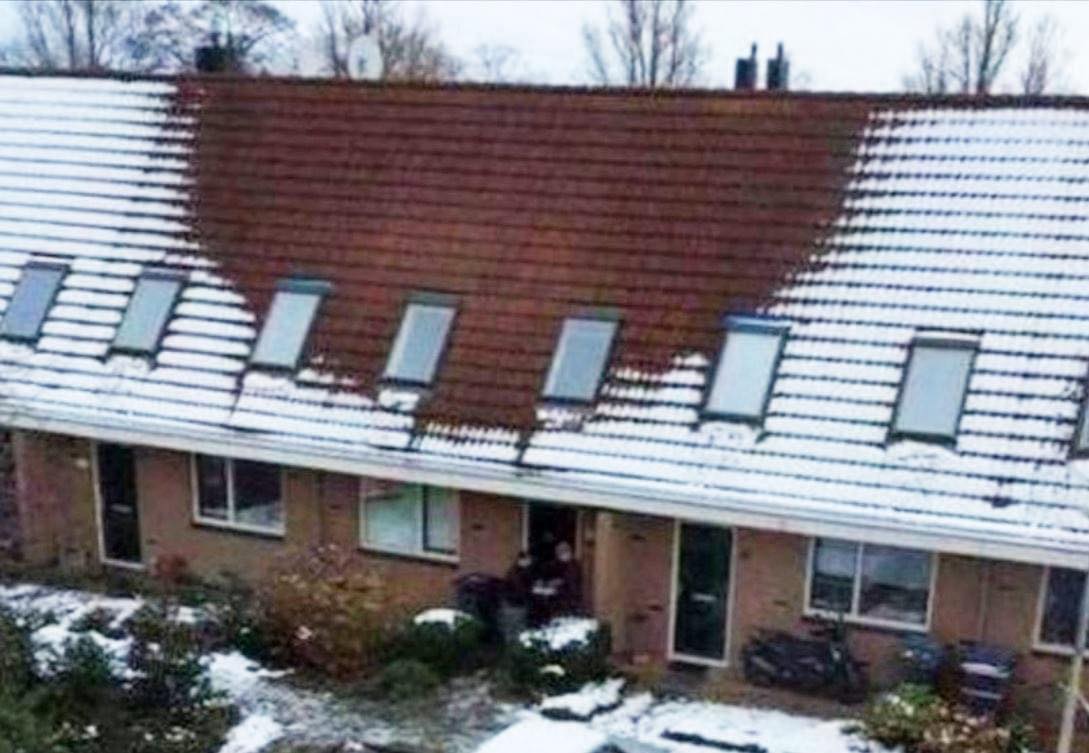Residents of a small Dutch town recently alerted the police after noticing something very peculiar happening at a neighbor’s home. The town was blanketed in heavy snowfall, and snow continued to accumulate everywhere—except on the roof of one specific house. This odd sight raised suspicions among the residents, leading them to contact law enforcement.
When officers arrived to investigate, they quickly uncovered the reason behind the snow-free roof. Inside the house was a thriving cannabis-growing operation. The heat generated by the grow lights and other equipment used to cultivate the plants created enough warmth to prevent snow from sticking to the roof. This inadvertent clue led to the exposure of the illegal activity, resulting in the arrest of the homeowner.

The Dutch police have recently been cracking down on illegal cannabis operations, and this unusual case is one of several that have been uncovered due to melting snow. While heavy snowfall is usually a serene and picturesque aspect of winter, it has inadvertently become an ally for law enforcement in identifying illicit grow houses. In these instances, the lack of snow on rooftops serves as a clear indicator of significant heat production inside—a telltale sign of indoor cannabis cultivation.
This particular incident has shone a spotlight on the Netherlands’ complex relationship with marijuana. Although the country is often perceived as one of the most tolerant in the world when it comes to cannabis use, this perception doesn’t tell the full story. While personal marijuana consumption is generally decriminalized, and small quantities can be purchased in regulated coffee shops, the cultivation of cannabis remains strictly controlled. Dutch law permits individuals to grow up to five plants for personal use. However, anything beyond this limit is considered a criminal offense, and those caught exceeding it face serious legal consequences.
In this case, the individual responsible for the illegal grow operation far exceeded the permissible number of plants. The cultivation setup inside the home was designed to produce a substantial quantity of cannabis, likely for distribution rather than personal use. As a result, the individual now faces the prospect of several years in prison. This outcome highlights the significant penalties associated with large-scale cannabis cultivation, even in a country known for its relatively liberal stance on marijuana.
The discovery of such operations often comes as a shock to neighbors, many of whom are unaware of what’s happening right next door. In this instance, the peculiar sight of a snow-free roof was the only outward sign of the activity taking place inside. Without the heavy snowfall, it’s possible the operation might have gone unnoticed for much longer.
The phenomenon of melting snow exposing grow houses is not unique to this case. Law enforcement agencies in the Netherlands have reported similar discoveries in recent years, particularly during colder months. The intense heat required to sustain indoor cannabis cultivation often becomes visible in snowy conditions, as rooftops or other areas of the property appear warmer than their surroundings. This unintentional side effect of the cultivation process has proven to be a valuable tool for police in identifying illegal activities.
In addition to the lack of snow, other indicators can also raise red flags for authorities. Excessive electricity consumption, for example, is often a giveaway. Cannabis grow houses typically use high-powered lights, ventilation systems, and heating equipment, all of which require a significant amount of energy. In some cases, individuals attempting to avoid detection may illegally bypass electricity meters, leading to dangerous situations such as fires or electrical malfunctions.
While these cases underscore the risks associated with illegal cannabis cultivation, they also highlight the ongoing challenges in regulating marijuana production. The Netherlands’ unique approach to marijuana policy—permitting personal use but restricting large-scale cultivation—creates a gray area that can be exploited by criminal enterprises. For years, drug lords have taken advantage of these regulatory gaps, using homes, warehouses, and other properties to grow cannabis for both domestic and international markets.
Efforts to combat illegal cultivation have ramped up in recent years, with law enforcement employing various strategies to identify and dismantle grow operations. In addition to monitoring electricity usage and responding to tips from the public, some police departments have begun using advanced technology, such as thermal imaging, to detect heat patterns consistent with indoor cannabis cultivation. These methods, combined with the inadvertent help provided by snowy weather, have led to the closure of numerous grow houses and the arrest of those responsible.
For the residents of the small Dutch town, this case serves as a reminder of the importance of vigilance and community awareness. The neighbors who noticed the snow-free roof and reported their suspicions to the police played a crucial role in uncovering the illegal activity. Their actions not only helped put an end to the grow operation but also contributed to ensuring the safety of their community.
This incident also raises broader questions about the effectiveness of current marijuana policies. While the Netherlands is often celebrated for its progressive approach, the strict limits on cannabis cultivation create challenges for those seeking to operate within the bounds of the law. Some advocates argue that further regulation and legalization of cannabis production could help reduce the prevalence of illegal grow houses, while others contend that strict enforcement is necessary to prevent misuse and protect public safety.
For now, the case of the snow-free roof serves as an unusual yet effective example of how even the most mundane aspects of winter can have unexpected consequences. As Dutch authorities continue their efforts to crack down on illegal cannabis operations, it’s likely that melting snow and other weather-related clues will remain an important tool in their arsenal. For those involved in illegal activities, it’s a stark reminder that even the smallest details can lead to exposure—and ultimately, accountability.
